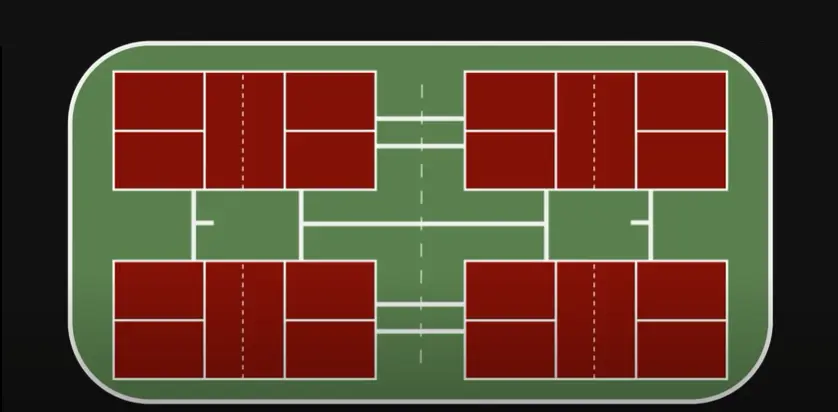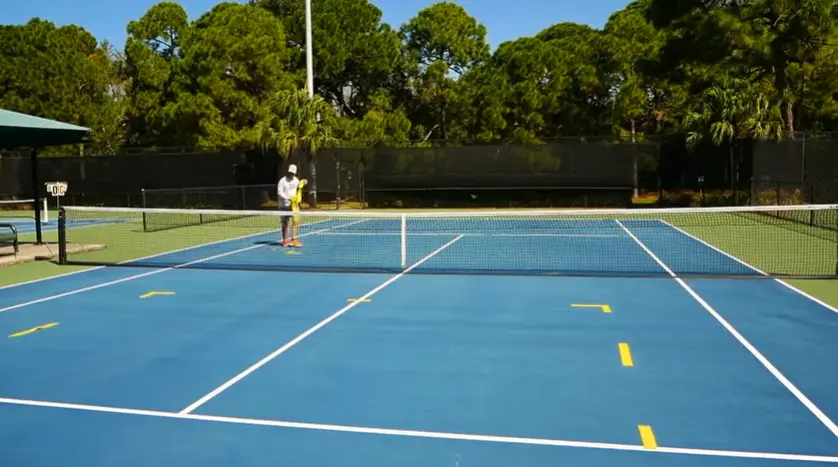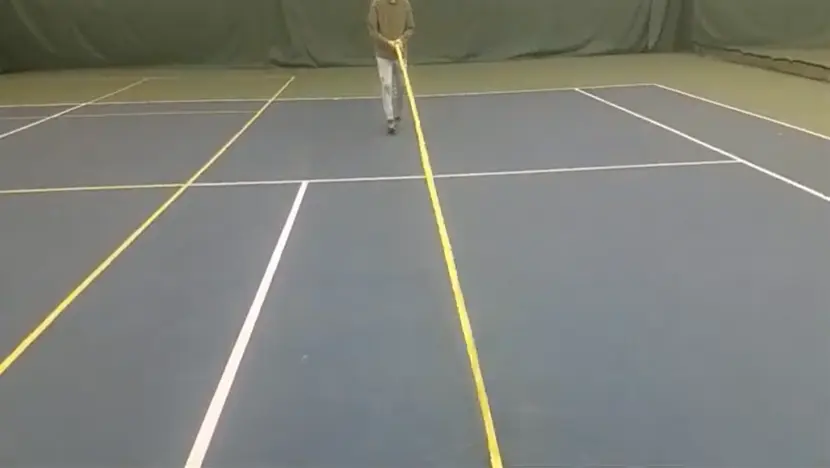As someone who loves playing pickleball, I know how important it is to have access to a court. But what if there are no dedicated pickleball courts in your area?
Well, don’t worry – you might be able to play on a tennis court! Yes, it’s true – pickleball can be played on a tennis court, even if the lines and nets are different.
In fact, the Tennis Industry Association estimates that there are hundreds of thousands of tennis courts in the United States alone, meaning there are many potential places to play pickleball.
So, in this article, I’ll show you how to play pickleball on a tennis court, and explain how this can benefit you and your friends. Whether you’re a seasoned pickleball player or just starting out, this information can help you enjoy the game even more!
Do Not Forget to Read: Latest Pickleball Paddles
Can You Play Pickleball On A Tennis Court
The answer is a resounding yes! Pickleball can be played on a tennis court, making the game more accessible for fans.
In fact, playing pickleball on a tennis court is becoming increasingly common. According to the Tennis Industry Association, there are approximately 270,000 tennis courts in the United States alone.
This means that there are hundreds of thousands of places to play pickleball, and chances are good that there’s one near you.
Some tennis courts may already have pickleball lines on them, either permanently or because players have left them in place. These lines are usually a different color from the tennis lines, making them easy to distinguish.
If the court doesn’t have pickleball lines, however, it’s easy to customize it. All you need is some tape, chalk, or a portable net to create a temporary pickleball court.
One of the biggest concerns that people have when playing pickleball on a tennis court is whether or not it will damage the court. Fortunately, pickleball is a relatively gentle game that is unlikely to cause any harm to a tennis court.
However, it’s important to make sure that the court is clean and free of debris before playing, as this can cause damage over time.

It’s also important to note that there is a size difference between a pickleball court and a tennis court. A standard pickleball court measures 20 feet by 44 feet, while a standard tennis court is much larger, measuring 78 feet by 36 feet.
This means that if you’re playing pickleball on a tennis court, you’ll need to adjust your game accordingly. You can either use the pickleball lines if they’re available or use the tennis court as a guideline for where to place your temporary lines.
Many tennis players are now playing pickleball on their existing tennis courts, which is great news for the sport. It’s an easy and affordable way to try out a new game without having to invest in new equipment or find a new place to play.
With a few minor adjustments, anyone can turn a tennis court into a pickleball court and enjoy this exciting and fast-paced sport.
Do Not Forget to Read: Pickleball Court Color Schemes
Differences between Pickleball Courts and Tennis Courts
Pickleball and tennis are two popular racquet sports that have many similarities. Both sports involve hitting a ball back and forth over a net and can be played as singles or doubles.
However, there are some significant differences between the two sports when it comes to their playing surfaces.
Size of the Courts
One of the most noticeable differences between pickleball and tennis courts is their size. Pickleball courts are significantly smaller than tennis courts.

A standard pickleball court is 44 feet long and 20 feet wide, including the lines. In contrast, a tennis court is 78 feet long and 27 feet wide. This size difference can impact the speed of the game, the physical demands on the players, and the strategies employed by players.
Net Height
Another significant difference between pickleball and tennis courts is the height of the net. Pickleball nets are lower than tennis nets, which affects the types of shots that can be played.
The pickleball net is 36 inches high at the sidelines and 34 inches high in the middle. In comparison, the tennis net is 42 inches high at the sidelines and 36 inches high in the middle.
The Kitchen
Pickleball courts have a unique feature called “The Kitchen,” which is a 7-foot no-volley zone located on both sides of the net.
Players are not allowed to hit the ball out of the air within this zone, which is designed to prevent players from dominating the game with powerful smashes. In contrast, tennis courts do not have a no-volley zone.
Court Configuration
Both pickleball and tennis courts share similar boundary, middle, and sideline lines. However, the configuration of the lines is different between the two courts. Pickleball courts have a larger service area and a smaller court area than tennis courts. Additionally, there are additional lines that indicate the no-volley zone and the serve area.
Multiple Pickleball Courts on a Tennis Court
An interesting feature of pickleball and tennis courts is that you can fit four pickleball courts within one standard tennis court.

This means that up to 16 people can play pickleball at once on a single tennis court. This is a great way to maximize the use of a tennis court and make it accessible to more people.
Do Not Forget to Read: Can You Play Pickleball On A Wet Court?
Understanding Different Lines for Pickleball vs. Tennis
Pickleball and tennis are two popular racquet sports that share similarities but also have several key differences, including the sets of lines used on their respective courts. Understanding these differences is crucial to enjoy the game and play with the correct rules.
The Four Sets of Lines

Both pickleball and tennis have four sets of lines that include the side lines, service lines or baselines, center lines, and the kitchen line or non-volley zone line. However, these lines are located differently on each court.
The Kitchen Line
The kitchen line is unique to pickleball and marks the no-volley zone where players are not allowed to hit the ball before it bounces. It’s located 7 feet from the net on either side of the court, and its purpose is to prevent players from dominating the game with their volley skills.
Using a Tennis Net for Pickleball
Pickleball and tennis nets differ in height. A pickleball net is 36 inches tall where it’s attached at the side posts and 34 inches tall in the center, while a tennis net is 42 inches high at the posts and 36 inches high in the center.
These few inches might not seem significant, but they can make a big difference in the game.If you’re playing pickleball on a tennis court, you can use a tennis net if it’s adjustable or if you’re playing casually and don’t mind the height difference.
Adjustable nets are becoming more common as pickleball’s popularity rises. You can also use tennis net adjusters to constrict a tennis net to the proper pickleball size.
However, most players prefer using their own pickleball nets with the correct height for the best playing experience. It’s recommended to use a pickleball net when possible.
Further Information: Does Pickleball Damage Tennis Courts?
Do Not Forget to Read: How Much Does It Cost To Paint A Pickleball Court?
How to Draw Your Own Pickleball Lines on a Tennis Court
It is possible to draw your own pickleball lines on a tennis court to create a makeshift pickleball court. This is a useful option for players who do not have access to a dedicated pickleball court.
To draw pickleball lines on a tennis court, you will need a measuring tape, temporary markers (such as chalk), and tape to mark the lines. First, set up the net in the middle of one side of the tennis court.

Then, mark the first sideline by starting your measuring tape a foot inside the net and extending a 22-foot line away from the net. Next, mark the baseline by measuring 20 feet from the 22-foot mark on the sideline, and marking the halfway point at 10 feet.
To mark the second sideline, start a foot inside the net on the opposite side post and connect a straight line out to the end of the baseline. The non-volley zone or “kitchen” is marked 7 feet from the net on each sideline, with a halfway point at 10 feet.
Connect the two halfway points, one halfway along the baseline and one across the kitchen line. Finally, tape along the lines by stretching the tape from the base point to the end point and gently pressing it down.
It is important to note that a pickleball court is about a fourth of the size of a tennis court. Therefore, drawing your own pickleball lines on a tennis court involves subdividing the court accurately. For fair gameplay, the measurements and markings must be precise.
However, this option allows for up to four pickleball courts to fit in the space of one tennis court.

If you are not familiar with the dimensions of a pickleball court, it is recommended that you refer to an introduction to pickleball. While chalk or another temporary marker can be used to mark the lines, temporary tape such as painter’s tape can be used to lay the lines.
By drawing your own pickleball lines on a tennis court, you can enjoy pickleball play when there is no access to a dedicated pickleball court.
Pickleball Net Height vs. Tennis Net Height
Although the pickleball and tennis nets may appear similar, they are different in height, especially for professional players. The height of a pickleball net is 36 inches at the side posts and 34 inches at the middle.
In comparison, a tennis net is 42 inches high at the side post and 36 inches high in the middle. Therefore, a pickleball net is two inches lower than a tennis net. These differences in height may not be noticeable to the casual player, but they are crucial for professional players, who must adjust their game accordingly.
Do Not Forget to Read: How To Become A Pro Pickleball Player
What is the Cost of Converting a Tennis Court into a Pickleball Court?
Converting a tennis court into a pickleball court is a great way to utilize underutilized tennis courts and provide economic benefits for the community. The cost of conversion varies based on the permanence of the solution and materials used.
Temporary lines are a cost-effective option for players and can be applied using chalk, temporary tape, and measuring tape for less than $25.
However, for those who want a more permanent solution, professionally adding permanent pickleball lines can cost between $200 and $600. DIY solutions are not recommended as mistakes can be difficult to undo.
Adding permanent pickleball lines to pre-existing tennis courts is a popular option for private communities with court amenities, but it is important to note that it is illegal to add lines to public or private courts without permission.
A complete conversion from a tennis court to a pickleball court can cost tens of thousands of dollars based on various factors such as the materials used for the original court and its condition. Resurfacing the court can significantly increase the cost.
Despite the cost, many communities are converting tennis courts to pickleball courts as it provides an opportunity for increased physical activity in the community and gives underutilized tennis courts a new lease on life.
Communities with an interest in pickleball are taking advantage of existing tennis courts to create new pickleball courts. This trend is growing across the country as more people become interested in the sport.
By converting tennis courts into pickleball courts, communities are able to promote physical activity and provide economic benefits for their residents.
How to Play Pickleball on a Tennis Court: A Step-by-Step Guide
Pickleball is a popular sport that combines elements of tennis, badminton, and ping-pong. While dedicated pickleball courts are available in many locations, pickleball can also be played on a tennis court. Here’s how to set up a pickleball court on a tennis court in just a few easy steps.
Step 1: Gather the necessary equipment.
Before you begin, you’ll need to gather some equipment. You’ll need a temporary pickleball net or an adjustable tennis net, measuring tapes, chalk or temporary marker, and painter’s tape. Remember, all materials and markings should be temporary if you don’t want to permanently convert the tennis court to a pickleball court.
Step 2: Set up your net in the middle of the half-side of the tennis court.
The net should be set up in the middle of the half-side of the tennis court, so each half of the tennis court contains the whole pickleball court.
Step 3: Measure the sidelines of the court using three measuring tapes.
Starting your measuring tape about a foot inside the net, pull it out to 22 feet. Use chalk or a temporary marker to make a line along the edge. Repeat this process to get to the other sideline and connect it to the 20-foot mark of the baseline.
Step 4: Measure the baseline from the 22-foot mark of the sideline and extend the baseline tape out to 20 feet.
Make a mark when you get to 10 feet (halfway) and trace down the edge of the measuring tape with chalk. Repeat this process to get to the other sideline and connect it to the 20-foot mark of the baseline.
Step 5: Mark the non-volley zone.
To mark the non-volley zone, measure 7 feet from the net on the sideline. Run your chalk to connect to the other sidelines at the 7-foot mark of the other sidelines, and make a mark halfway (10 feet).
Step 6: Connect the 10 feet marked at both the baseline and the non-volley area.
Connect the 10 feet marked at both the baseline and the non-volley area to complete the pickleball court.
Step 7: Tape along the lines, hold one end, and stretch it all the way out.

Slowly lower it down onto the chalk, tapping it to secure it. Repeat the process on the other side.
Step 8: Congratulations!
You have successfully set up your own 44-foot pickleball court on a tennis court.
Do Not Forget to Read: How To Hold A Pickleball Paddle
Final Words
In conclusion, playing pickleball on a tennis court is a viable option for those who don’t have access to a dedicated pickleball court.
It’s becoming increasingly common and is an easy and affordable way to try out a new game without having to invest in new equipment or find a new place to play.
It’s also relatively gentle on a tennis court and unlikely to cause any damage, as long as the court is clean and free of debris.
However, it’s important to note the differences between the two courts, including size, net height, and the presence of “The Kitchen” on a pickleball court. With a few minor adjustments, anyone can turn a tennis court into a pickleball court and enjoy this exciting and fast-paced sport.
Do Not Forget to Read: How To Clean Pickleball Paddle

Michael Stevenson
Hi, my name is Michael Stevenson and I’m a passionate pickleball player. I’ve been playing the game for many years and I’m pretty highly skilled at it. Pickleball is one of my favorite topics so naturally, I love to write about it.
Whether it’s tips for beginners, guides for experts, reviews of new paddles, or advanced playing techniques – if it relates to pickleball then I have something interesting to write about it. So if you’re looking for entertaining and informative information on the topic of pickleball, look no further than my written works!